ISSN ONLINE(2278-8875) PRINT (2320-3765)
ISSN ONLINE(2278-8875) PRINT (2320-3765)
Neetu Kumari1, Nikita Patel2, Satyajit Anand3, Partha Pratim Bhattacharya4
|
| Related article at Pubmed, Scholar Google |
Visit for more related articles at International Journal of Advanced Research in Electrical, Electronics and Instrumentation Engineering
In wireless sensor networks (WSN), the nodes are low powered devices and hence designing a low power WSN is highly important for getting longer lifetime. In this paper, we have discussed several aspects of design and operations of low power WSN. We have reviewed and critically analysed different design issues such as dynamic power management, ultra-low power node design, duty cycle assignment and medium access control.
Keywords |
| Wireless sensor network, network lifetime, dynamic power management, ultra low power node design, duty Cycle and Medium access control |
INTRODUCTION |
| Wireless Sensor Networks (WSNs) refers to highly distributed networks of small and lightweight wireless nodes deployed in large numbers to monitors the environment or system by measuring physical parameters such as temperature, pressure, humidity etc. Each sensor node has a microprocessor and a small amount of memory for signal processing and task scheduling. Each node is equipped one or more sensing devices such as acoustic microphone arrays, video or still cameras, infrared, seismic, or magnetic sensors. Each sensor node communicates wirelessly with a few other local nodes within its radio communication range. The structural view of sensor network is shown in Fig. 1. |
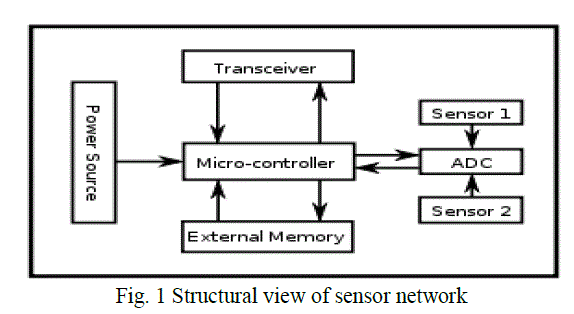 |
| Wireless sensor network is made up of four components: Sensing unit, processing unit, transmission unit and power unit [1]. |
| ïÃâ÷ Sensing unit: Sensing unit consist of sensor and analog to digital converters (ADCs). Sensor convert physical phenomenon to electrical signals. The analog signals produced by sensor are converted to digital signals by ADC |
| ïÃâ÷ Processing unit: The processing unit consists of microprocessor or microcontroller whose main task is to control sensors, execution of communication protocols and signal processing algorithms on the gathered sensor data. |
| ïÃâ÷ Transmission unit: Transmission unit receives the information from the CPU and then transmit it to the outside world. |
| Power unit: In wireless sensor network, battery power is the main source of energy. So power unit regulates the battery power to sensor node. |
| A. WSN Implementation Requirements |
| In order to make these networks a reality, the node hardware and implementation should be optimized for three characteristics |
| ïÃâ÷ Low cost: The utility of the networks depends on high density of nodes. In order to make large scale deployments economically feasible, nodes must be of very low cost |
| ïÃâ÷ Small size: For the same reasons, the size of modules must be of small size so that the network is unobtrusive. |
| ïÃâ÷ Low power: For large networks with many nodes, battery replacement is very difficult, expensive or even impossible. Nodes must have efficient energy so that it can function for long periods without running out of power. |
| B. Applications of WSNs |
| Applications of wireless sensor network are in - |
| ïÃâ÷ Security and Surveillance: Security and surveillance are important applications of wireless sensor networks. Sensors can be used to improve the safety of roads by providing warnings of approaching cars at intersections [2]. Image or video sensors can be very useful in identifying and tracking moving entities |
| ïÃâ÷ Industrial Monitoring: Wireless sensors can be used to monitor manufacturing processes and conditions of industrial equipment to alert for imminent failures. This reduces cost for service and maintenance, increase machine up-time, improve customer satisfaction and even save lives. |
| ïÃâ÷ Agriculture: Wireless sensor network allow users to make precise monitoring of crops at the time of its growth [3]. Hence, farmer can immediately know the state of the item at all its stages which will ease the decision process regarding the time of harvest |
| ïÃâ÷ Smart Home Monitoring: Wireless sensors embedded within everyday object forming a wireless sensor network is used to monitor the activities performed in a smart home |
| ïÃâ÷ Environmental Monitoring: Sensors can be used to monitor air quality and track environmental pollutants, wildfires or any other natural or manmade disasters. Sensors can also monitor biological or chemical hazards to provide early warnings. |
II. IMPORTANCE OF LOW POWER DESIGN IN WIRELESS SENSOR NETWORKS |
| Wireless sensor networks use large quantity of sensor nodes deployed in target area for performing several tasks such as environmental monitoring, military surveillance, animal tracking etc. Each sensor node collects information by sensing its surrounding and then transfers the information to a sink via wireless transmission. Different from other battery-powered apparatuses, recharging a sensor’s battery is generally impossible task. Although solar and wind energy can be used, but such energy supplies are not reliable. Therefore, network lifetime is a key issue in wireless sensor networks where sensor nodes, distributed typically in remote sensing areas, are powered by finite energy batteries which are not easily replaced or recharged. Depletion of these finite energy batteries can result in a change in network topology or end of network life itself. Hence, prolonging the life of wireless sensor networks is important [4]. Depletion of these finite energy batteries can result in a change in network topology or in the end of network life itself. Energy consumed in wireless sensor nodes can be for the purpose of sensing, processing and communication. |
| ïÃâ÷ Network Lifetime Based on Sensor Coverage: The region of interest can be a two-dimensional area or a threedimensional volume where each point inside the area or volume has to be covered. This is referred as area or volume coverage. If only a finite set of target points inside an area has to be covered, the coverage problem is called target coverage. The third coverage problem is called barrier coverage. It describes the chance that a mobile target can pass undetected through a barrier of sensor nodes. There are two ways to describe the degree of coverage redundancy that can be achieved by a wireless sensor network. The first approach requires that only a given percentage α, of the region of interest is covered by at least one sensor. This is termed as α-coverage. The second approach aims to achieve more redundancy, and therefore requires that each point inside the region of interest is covered by at least k sensors. This is termed as k-coverage. |
| ïÃâ÷ Network Lifetime Based on Connectivity: |
| Connectivity is a metric that is commonly encountered in the context of ad hoc network. The definition for ad hoc network lifetime given by Blough and Santi in [5] defines the lifetime as the minimum time when either the percentage of a live nodes or the size of the largest connected component of the network drop below a specified threshold. However, this definition only considers the size of the largest connected component in the network. This is clearly insufficient in WSNs where connectivity towards a base station matters most. |
| In the next section, we have discussed different strategies for low power design and operations. |
III. LOW POWER DESIGN |
| Low power designing of wireless sensor network is a challenging issue and can be handled in various ways. Few of them are addressed below. |
| A. Dynamic Power Management |
| Dynamic power management (DPM) scheme has been introduced to reduce the power consumption without degrading the performance. In [6], Durga Prasad Bavirisetti, Nagendra Prasad Mandru and Sibaram Khara proposed an algorithm which yields reduced power consumption and satisfactory lifetime. In this algorithm missed events when sensor node is in deepest sleep state is not considered. This problem is subjected to our future research. There are three different approaches to a DPM strategy: |
| 1. Dynamic operation modes |
| 2. Dynamic scaling |
| 3. Task Scheduling |
| 1) Dynamic Operation modes: The main aim of Dynamic Power Management (DPM) technique is to shut down the devices when not needed and wake them up when necessary. However, it is not easy task to decide which node should remain active and which should shut down at a given time. Depending on the present and anticipated activity, the subsystems of a wireless sensor node can be configured to operate in different power modes. There exist different states depending upon different states of components as shown in table I [7]. If all the components are in active state, that state is called active state and is represented as S0. And if all the components are in off state, the state is called deepest sleep state and is represented as S0. |
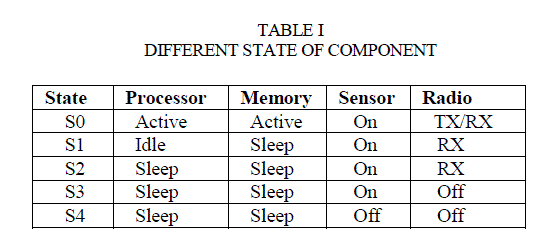 |
| 2) Dynamic scaling: With Dynamic voltage scaling (DVS) and dynamic frequency scaling (DFS), the supply voltage and clock frequency of some of the subsystems of a wireless sensor node are scaled down according to the present and anticipated workload, so that each task is computed in a planned manner. Reduction in the operation frequency results in energy saving in a linear manner. Whereas, reduction in the supply voltage results in quadratic energy saving. These two approaches adapt the performance of the processor core when it is in the active state |
| 3) Task scheduling: The battery aware task scheduling method is one kind of system level low power design schemes generally implemented as part of the embedded operating system. This method is based on the analysis of the batter y model and treats battery discharge as an additional constraint on task scheduling. To achieve the best scheduling efficiency supplied by high level algorithms, when a task is running, only the related hardware is activated. |
| B. Medium Access Control |
| The main purpose of MAC layer is to ensure efficient use of the physical communication channel by the nodes of a network, providing error free data transfer to the network layer above it. The design of a protocol for MAC can be oriented towards the accomplishment of several, often contradictory factors, with most important being throughput, power consumption, delay and quality of service (QoS). Energy management plays very important role while designing MAC protocol for wireless sensor network. So, design of an energy-efficient MAC protocol should be based upon the following guidelines: |
| • Collision avoidance: The simultaneous transmission from more than one sensor nodes and the consecutive retransmission need, lead to undesirable energy wastage and reduces the throughput of the system. Therefore, this should be avoided as far as possible. |
| • Idle listening periods, during which the node is listening to the communication channel without actually receiving data, should be eliminated. In this way, the amount of energy spent on monitoring the channel can be minimized |
| • Energy outspending due to lack of transmission-reception power level according to topology specific criteria, badly affects power consumption. Sophisticated and dynamic decision of this level can ensure communication between two nodes without wasting energy. |
| The MAC protocol proposed by I. E. Lamprinos, A. Prentza, E. Sakka, and D. Koutsouris in [8] has master-slave architecture, with all medical sensor nodes being designated as slaves, while the MIU (Mobile Interface Unit) node acts as the master of the patient’s PAN. The MIU node normally initiates data exchange by transmitting set up information to each sensor node. Each sensor is assigned a unique transducer address, and the system has a globally unique address. Transmission from slaves to master is based on request to send or allow send scheme. Data exchange is optionally acknowledged and subjected to error correction, using Forward Error Control (FEC) and retransmission to ensure no data loss. |
| S-MAC: S-MAC is a low power protocol for wireless sensor networks. The main contribution of the Sensor-MAC protocol [9] is that its fixed duty-cycle approach is simple and effective in reducing idle listening overhead. S-MAC periodically sleeps, wakes up, listens to the channel, and then returns to sleep. Each active period is of fixed size, with a variable sleep period. The length of the sleep period dictates the duty cycle of S-MAC. The only complicated part is the synchronization of the nodes. Nodes regularly broadcast SYNC packets including a time stamp at the beginning of a slot, which allows others to adjust their local clocks to compensate for drift. New nodes wanting to join the ad-hoc network start off with listening for an initialization period spanning multiple slots waiting for a SYNC packet to inform them about the common schedule. If no SYNC packet is received a node concludes it is the first one to form a so-called virtual cluster and starts broadcasting SYNC packets so others can join in later. |
| T-MAC: S-MAC using a fixed duty cycle has two drawbacks. First, an application developer is left with the burden of selecting the optimal duty cycle before deployment commences. Second, traffic fluctuations can only be dealt with by setting the duty cycle to the maximum load at any moment, at any location in the network. In this regard event-based reporting leaves S-MAC wasting lots of energy. So, Timeout MAC (T-MAC) protocol by van Dam and Langendoen [10] introduced an adaptive active period. By default nodes listen only for a short duration at the beginning of a slot and go back to sleep when no communication happens. If, on the other hand, a node engages or overhears a message transfer, it will schedule another listen period after this transfer to determine if it can then go to sleep. The node will stay active until no communication has been observed |
| DMAC: The protocols discussed above compromise on latency. When an application injects a message into the network, that message must wait for the next slot to turn up before it can be sent in the first place. Then additional delays may be encountered at each intermediate node. With S-MAC a message may travel multiple hops depending on the length of the active period. With T-MAC the number of hops per slot is limited to three due to the early sleeping effect. |
| The Data gathering MAC [11] addresses the latency issue for the converge-cast communication pattern. DMAC was originally designed to improve S-MAC and T-MAC. DMAC uses simple CSMA with acknowledgements. Nodes losing contention need not wait forth next upwards flow, but may try again in an over flow slot scheduled after any occupied Receive/Send pair. To account for interference with traffic higher up in the tree, these over flow pairs are scheduled with a three slot gap. The over flow slots essentially increase capacity on demand making DMAC automatically adapt to the traffic load, much like T-MAC's extension of the active period. The down side of DMAC is that it lacks the flexibility to support communication patterns. |
| C. Ultra Low Power Sensor Node in WSN |
| Wireless sensor networks (WSNs) consist of a large number of wireless sensor nodes deployed randomly in the area as shown in Fig. 2. The nodes collect the environmental data and send them through the network towards the sink node. The nodes are constructed to be operational for a long time without replacing the batteries. Therefore, one of the primary goals when designing sensor nodes is to reduce the power consumption. To minimize the power of a sensor node, researchers tend to combine novel architecture solutions with advanced power saving techniques [12]. |
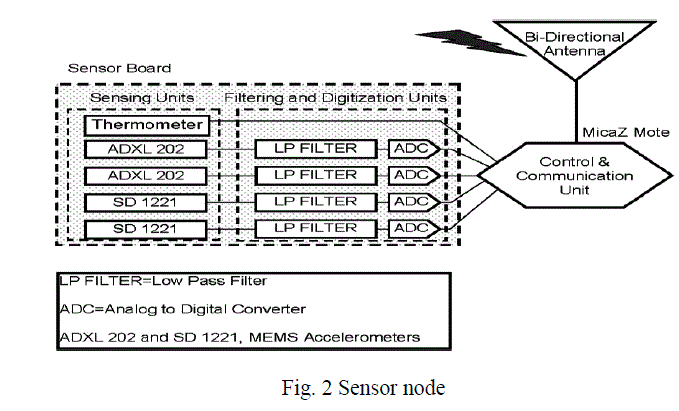 |
| 1) Architecture of Sensor Node: |
| ïÃâ÷ CPU: The processor is compatible to TIMSP430x family of controllers. All the Read and write instructions are executed in second half of the controller. The processor includes interrupt controller and I2C debug port. It is a soft core designed in VHDL. |
| ïÃâ÷ Timer: The timer is divided into external and internal clocks. Internally, clock divides in ratio of 2, 4 or 8 and external select clock. |
| ïÃâ÷ I/O Ports: I/O having 8 input output pins having interrupt capability individual. |
| ïÃâ÷ SPI Master: The SPI master core contains four 16-bit registers. It is used to supports edge selection and burst transactions by using 16 bit registers. |
| ïÃâ÷ Baseband Controller: It is basically for short range devices, and running at wake up support when it is implemented for maximum power of efficiency |
| ïÃâ÷ Memory Subsystem: It implemented 4kB of data RAM and an interface to an external Flash, we also integrated l kb RAM block that can be used as a boot memory [13]. |
| 2) Sensor Node Issues: |
| ïÃâ÷ Some designing issues are: |
| a. Sensor nodes must operate for months or years. |
| b. It should have compact and small in size. |
| c. Production cost must be low. |
| d. Security issues should be considered |
| e. Optimized for the high lifetime and with single battery charge. |
| ïÃâ÷ Some power issues are: |
| Total power=Static power+ Dynamic power |
| To minimize the power loss following procedure can be applied: |
| a. System components must be optimized. |
| b. Data traffic must be reduced. |
| c. Implement clock gating and dynamic frequency and voltage scaling [14]. |
| 3) Node Power Consumption and Optimization: |
| First step for identifying which part need more power supply in sensor node than the other is control unit which gives intelligence to a sensor node. The radio module of a sensor offers wireless communications with its external world. Several factors such as modulation scheme, data rate, duty cycle and transmission power effect radio module power consumptions. Normally radio modules work in four different steps: transmission, reception, idle and sleep. Now that we know which parts of a sensor node consume a significant amount of the battery current, minimizing power consumption is required. To achieve that, it is necessary to implement power-aware design methodologies and systems architectures that let the network be autonomous [15]. |
| Some techniques that provide power consumption reduction are: |
| • Dynamic Power Management (DPM) algorithms try to reduce system consumed energy making components go to low power consumption state selectively. |
| • Both Dynamic Voltage Scaling (DVS) and Dynamic Frequency Scaling (DFS) algorithms reduce power consumption varying a functional characteristic: voltage or frequency, respectively [16-21]. |
| • Dynamic Thermal Management (DTM) techniques offer power consumption reduction and increase system latency. However, sensor networks have parallel processing capability so if algorithm calculations are shared among some nodes, allowed latency to each one is higher |
D. Use of Relay Node in WSNs: |
| Sensor node is used to sense environment and it also generate data. By using wireless media the data from sensor node is transmitted towards the base station [22]. The relay node performs three sections of operations. They include a radio communication section (RCS) for transmitting/receiving the information, an information recording section (IRS) for storing the information received from the sensor node, and an information conveying section (ICS) for determining a destination of the information. The wireless sensor network is more self-configuring as there is no need for manually configuring .The use of relay nodes in sensor networks took attentions from researchers around the world. The use of relay nodes mainly proposed for maximizing the network lifetime, energy efficient data gathering, load-balanced data gathering as well as making the network fault tolerant [23]. |
| The main purpose of such deployment may be summarized as follows [24]: |
| • Extending the lifetime of sensor networks. |
| • Energy-efficient data gathering in sensor networks. |
| • Balanced data gathering in sensor networks. |
| • Providing fault tolerance in sensor networks. |
| In WSNs sensor node, a sensor node can transmit the information in two forms: Direct link and node to node delivery [22]. In second, no. of relay node is used which result into reduce power consumption is used for the transmission. For transmitting data from the source node to the destination node the router will act for node, amplify the data signal and forward it to next neighbour. Receiving, amplifying, and forwarding of the data can be expressed by the following models [25-28]. |
| 1) Relay Node Assisted WSN Architecture: |
| The basic sensor network architecture consists of several layers that communicate with the Relay node as shown in Fig. 3. |
| ïÃâ÷ Physical (PHY) Layer: The main function of physical layer is transmission of bits reliably over point-to-point wireless link, modulation and frequency Selection, coding, diversity and power control. |
| ïÃâ÷ Medium Access Control (MAC) Layer: MAC layer perform frame control and error detection. It control different user over a spectrum. |
| ïÃâ÷ Network Layer: It provides to transfer data sequence from source to destination. |
| ïÃâ÷ Application Layer: It generates the data to be send over the network and received data are processed over the network by the wireless sensor nodes which are low-powered and energy-constrained. Relay nodes are responsible for data packet fusion from the sensor nodes in their clusters and transmit them from the destination node processing [22]. |
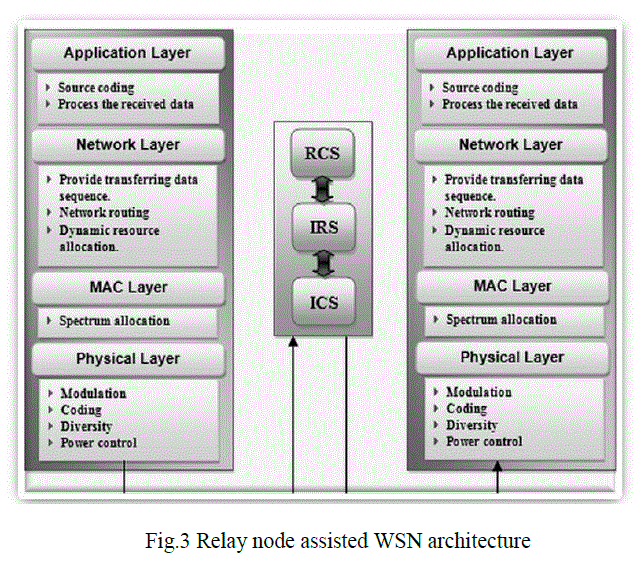 |
| E. Duty Cycle Control in WSN |
| Duty cycle is defined as the ratio of time that a mechanism spends in an active state, to spend in the active state [29]. The DCC protocol provides efficient management for node duty cycling within a WSN and MAC protocol mostly uses duty cycling to reduce energy. Application of duty cycle is to decrease energy needed to turn on a device, only when necessary, otherwise keep it off. Therefore, “ratio of time spent on” to “time spent off” is known as duty cycle dc. Less energy is required for lower DC [30]. It doesn’t require continuous sampling or communication which makes its operation applicable in WSN [31]. It is one of the most effective energy conserving operation in which the radio transceiver is placed in sleep mode whenever the communication is not required [32]. |
| To reduce power consumption and increase lifetime WSNs introduce two techniques: |
| a. Duty cycling |
| b. Data cycling control |
| a. Duty cycling approaches: Duty cycle approaches can be classified into three categories: Asynchronous DC, Synchronized or Scheduled DC and Hybrid approaches. Low power listening is used for asynchronous dc. The technique named Channel Polling, defined by maintaining sleeping and active time of radio. Adjusting time with the Preamble and Receiving time off and on time of radio is maintained in the network. It creates congestion in the channel and thus not used for the beneficial use. |
| b. Duty cycle control: Duty cycling is reduced according to the fixed sleeping and variable active modes. The off period is generally fixed, and the on period is variable depending on whether there is a transmission or not. This helps in reducing delay between transmissions. |
| 1) Multi-level duty cycling: |
| For simplicity predefined duty cycles are used by introducing low and high dc for idle and active modes respectively. The advantage is that the network need not use same dc throughout the network, shown in Fig. 4 |
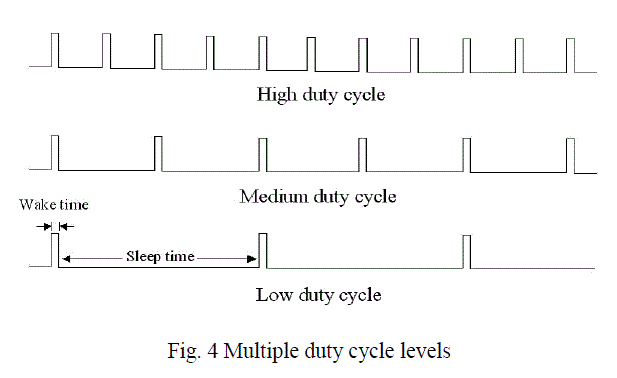 |
| Duty cycle rate control for Zones and Paths: Duty cycles are set according to request and control messages received. DC rates are set according to the table which is filled with dc requests. Highest request DC is used. If the table is empty then default lowest one is used. It takes one of two main forms: wake up or sleep message [30] |
| 2) Approach for DCC: |
| A differential duty cycle approach is designed based on energy consumed by both traffic and idle listening [33]. It assigns different duty cycles for nodes at different distances from the base station to address the energy hole-problem, improve network lifetime and also maintains network performance. |
| 3) Effect of Duty Cycle on Expected Energy Consumption: |
| The traffic relayed at a node is related to its distance to the sink, the packet traffic generated by each source node, the number of source nodes in the network and the node density. The time required for a transmission and the energy efficiency of the network is closely related to the duty cycle values used. Higher values of duty cycle provide more nodes available for data routing and thereby energy consumption of the nodes increases [18]. |
IV. CONCLUSION |
| In this paper, we have discussed different low power designing techniques of wireless sensor networks. It is seen that DPM scheme reduces power consumption by selectively shutting down idle components. The S-MAC reduces energy waste caused by packet collisions, idle listening, overhearing and overhead. Duty cycle control reduces energy requirements for a specified minimum latency within a network or section of a network. Future work includes design and simulation of low power WSN. |
References |
|